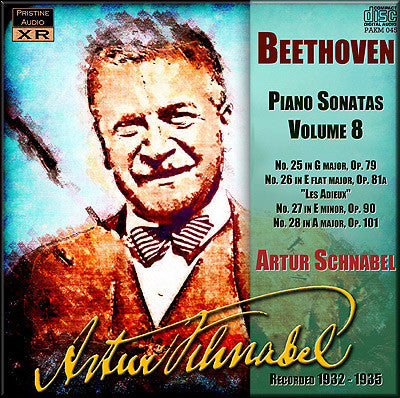
This album is included in the following sets:
This set contains the following albums:
- Producer's Note
- Full Track Listing
- Cover Art
Superb 32-bit XR-remastered Beethoven Sonatas from Schnabel
"The sound quality ... made me rethink my conception of Schnabel"
- Classical CD Review
This volume manages to span almost the entire recording time of Schnabel's Beethoven cycle, with the 27th Sonata dating from his first sessions in January 1932 and the 25th from the final recordings of November 1935 (the Naxos reissues suggest a single later re-recording session in 1937, but this is contradicted by Gray's discography from which we've sourced our information). What is surprising is the relative consistency in sound quality - if the very earliest sessions are perhaps slightly rougher around the edges it's a close-run thing, and all four sonatas, each recorded about a year or so apart hold together very well indeed. Technical problems common to each are common to most 78rpm recordings - surface noise and swish and occasional peak distortions. In each case I've been able to fix or reduce these, as well as applying effective pitch stabilisation and finding excellent sound quality through 32-bit XR remastering - as if "the performances had been bundled into a time machine and sent into the mono Fifties - no static, no hiss, no overbearing treble, and much truer to the live sound" as one reviewer (of Volumes 1 & 2 of this series) put it.
Andrew Rose
-
BEETHOVEN Piano Sonata No. 25 in G major, Op. 79
Recorded 15 November 1935, issued as HMV DB 3384
Matrix Numbers 2EA.2527-28
-
BEETHOVEN Piano Sonata No. 26 in E flat major, Op. 81a "Les Adieux"
Recorded 13 April 1933, issued as HMV DB 2091-92
Matrix Numbers 2B.6626-29
-
BEETHOVEN Piano Sonata No. 27 in E minor, Op. 90
Recorded 21 January 1932, issued as HMV DB 1654-55
Matrix Numbers 2B.2615-18
-
BEETHOVEN Piano Sonata No. 28 in A major, Op. 101
Recorded 24 April 1934, issued as HMV DB 2467-69
Matrix Numbers 2B.6152-56
Artur Schnabel piano
Gramophone Historic Review
He strikes right to the heart of the music.
1964 LP reissues
"After a concert in New York on January 20th, 1951, which was the last of his life Schnabel is reported to have said: "For the first time I succeeded today in playing that last line of Beethoven's Op. 90 so that I found it convincing". The story illustrates very well his constant search for perfection; in fact, he had a hearty distaste for recording because it fixed for ever something which he still wanted to improve and finished something which for him was unfinished. It's perhaps worth remembering this when we play his gramophone records. Though Karl Ulrich tells us his father was seldom satisfied with his own playing,
I would dare to assume that Schnabel was fairly well pleased with his performance of the E minor Sonata, Op. 90, as recorded on the first of these two discs—whatever reservations he might have had about the end of the second movement. Beethoven wrote the sonata as an engagement present for Count Lichnowsky and his unofficial titles for the two movements were "A contest between head and heart" and "Happy conversation with the beloved". There is no programme to the sonata implied here, but the titles do give a key to an interpretation and with Schnabel I get the impression that he uses exactly this key to unlock the full musical significance of the work. It's a marvellous performance.
Archduke Rudoff's sonata, the Sonata in E flat, Les Adieux, is arguably more extrovert. "A monument to the friendship of two men, deep as any friendship formed in schooldays or in the full stress of life, and manly as Beethoven's ripest art" Tovey called it; and Schnabel treats it so. In this performance the first movement is almost explosively passionate at times, but Schnabel never drives it too hard and the line of the music, shot through as this is with cunning references to the three-note Lebewohi figure which must always be allowed to tell, is admirably firm. The last movement, as one might have expected, is jubilant to a degree and tumbles over itself in its efforts to celebrate the Archduke's return; the speed and excitement are terrific.
The two-movement Sonata in F sharp and the little
German Sonata in G, Op. 79, are on the other side of the first record.
The F sharp major was one of Beethoven's own favourites; like the E
minor Sonata, Op. 90, it is a work of great subtlety. Prolific in
melodic detail, it shows in just over ten minutes proportions ranging
from a single bar to whole pages. Schnabel observes both repeats in the
first movement, an essential procedure if the work is to achieve its
proper stature, and he strikes right to the heart of the music. Again,
the finale is very fast and not always absolutely clear and steady; but
since the marking is allegro vivace and Schnabel manages even at this
speed to slur the semiquavers in pairs just as Beethoven indicated,
criticism (if any) must be of the execution, not the approach."
From The Gramophone, April 1964, by S.P.

